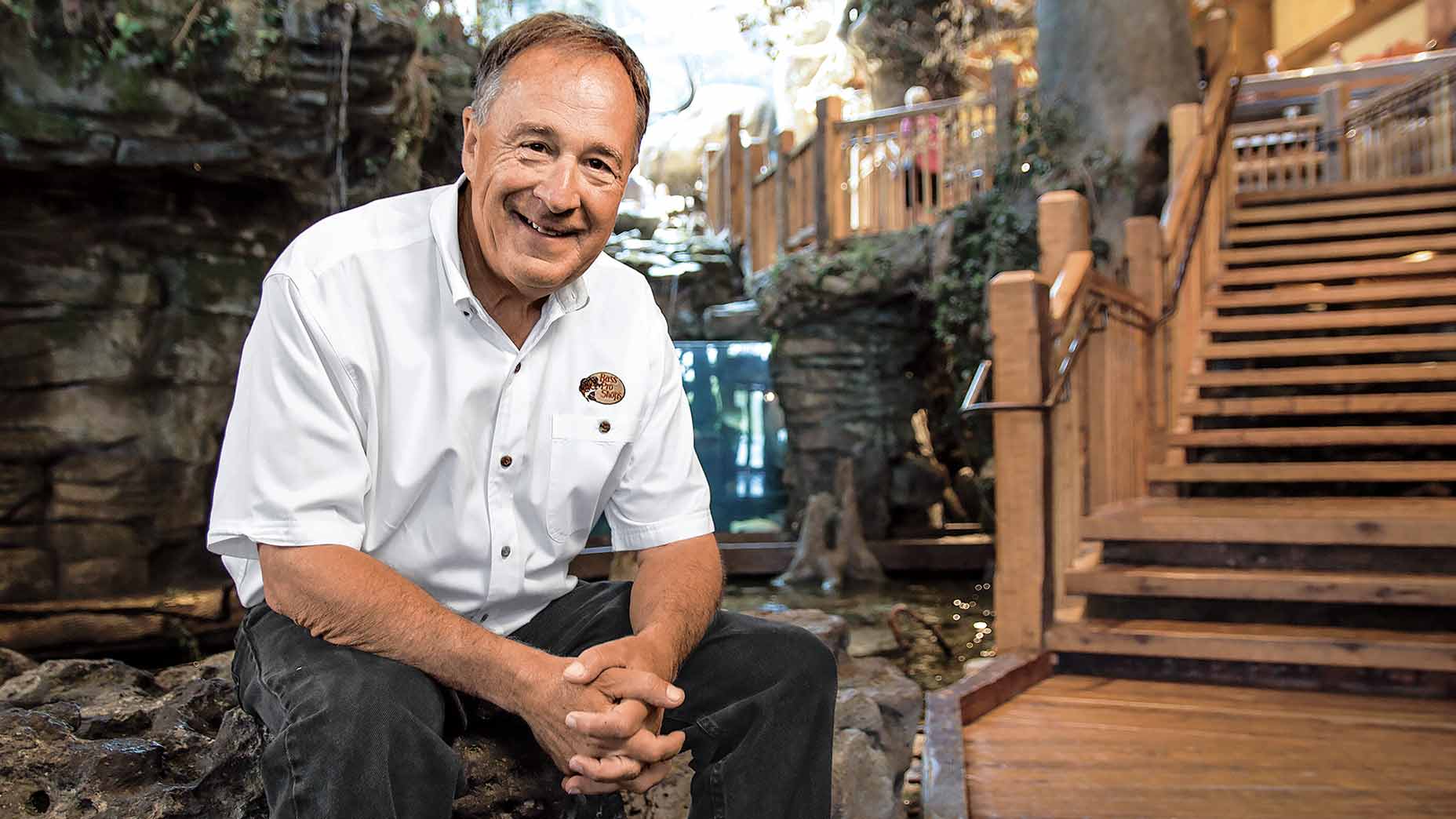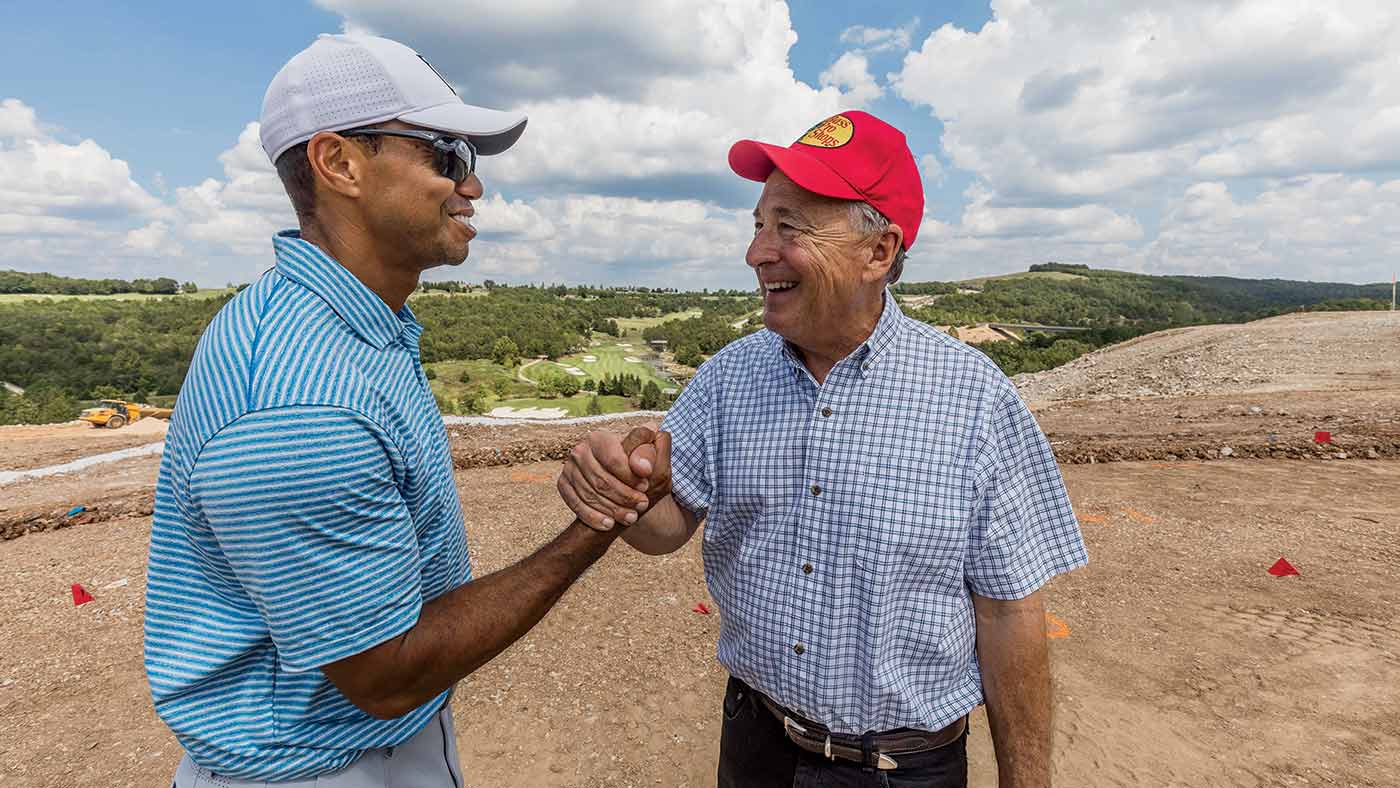Johnny Morris is best known as the founder of Bass Pro Shops. His golf empire in the Ozarks might change that

Johnny Morris, the chief visionary of Big Cedar’s sprawling wonderland.
Big Cedar Lodge
First, Johnny Morris turned his love of the outdoors into the multibillion-dollar Bass Pro Shops empire. Then the sport-fishing guru got his hooks into golf.
On a mid-May morning in 2015, at a golf resort in the Missouri Ozarks, the earth beneath a putting green began to rumble. Moments later, the ground gave way and a sinkhole opened, swallowing the green and turf around it. At most golf properties, the collapse of a swatch of playable terrain would constitute a crisis. But this took place at Big Cedar Lodge, owned by the sport-fishing magnate Johnny Morris. Morris was excited.
Rather than rush to fill the sinkhole, he dispatched work crews to excavate it, searching for a network of caves and waterways he rightly suspected lay below. The site, which Morris christened the “Cathedral of Nature,” became an over-night sensation. Some 70 feet wide and 200 feet deep, its belly bursting with limestone spires, it provides a look into the geologic past. It also gives a glimpse into the character of Morris, his out-of-the-box thinking and his vision for Big Cedar as a showcase of the Ozarks region, where he was born.

“To me, this part of the world is still largely undiscovered,” Morris says. “And that’s what this is really about — getting people out to experience the beauty of our rivers, lakes and hills.”
It’s a sun-splashed afternoon at Big Cedar, and Morris is standing on a piney ridge, taking in long views of a rolling landscape. At 74, he has a boyish energy about him and no shortage of outlets for it. Though not a hardcore golfer, Morris has transformed Big Cedar from a rustic getaway into one of the game’s fastest-growing marquee destinations. The property’s golf portfolio, which started taking shape in 1995 with the opening of Top of the Rock, a par-3 Jack Nicklaus design, has swelled to comprise five headline-name courses, including work by Gary Player, Tom Fazio and Bill Coore and Ben Crenshaw. The newest, opened in late 2020, is Payne’s Valley, Tiger Woods’ first public-access project in the United States.
Among the highlights of the course is a bonus 19th hole, a waterfall-backed par-3 that Morris dreamed up to underscore the spectacle of the surrounds. Its tee box is a perch with a panorama, and the path back to the clubhouse loops behind the falls, so that golfers close their rounds with a wilderness ride.
For such earthy imagineering, Morris has been called “the Walt Disney of the Ozarks.” Player, whose Mountain Top par-3 course at Big Cedar curls through layer-cake rock formations, describes him as a “creative visionary” with a knack for “inspiring a sense of wonder.” Because he knows he’s not an expert in course design, Morris never tries to strong-arm the architects he hires. But he likes to toss out ideas and tinker at the edges.
Take Ozarks National, Big Cedar’s rollicking Coore-Crenshaw layout. On the 13th hole, a par-5 spliced by a creek-forged ravine, the architects planned to build a low-lying bridge over the currents. Morris insisted on an elevated span to intensify the drama. The finished product — a striking, all-wood structure some 75 feet high that spills through treetops — is a crossing that doubles as a commanding lookout.
“Johnny would get so excited; he was like a kid out there,” Coore says. “You could tell how much he loved the idea of golf as a means to get people outside in a place so close to his heart.”
Morris fell for the outdoors early. The second of four kids in a family whose Ozarks roots reached back generations, he enjoyed a free-range childhood, pitching tents on gravel riverbeds, trapping crawdads in the shallows — a Huck Finn upbringing that was also part Horatio Alger tale. When Morris was 10, the construction of a hydroelectric dam on the White River created Table Rock Lake, a newly formed epicenter of a nationwide bass-fishing boom. By the time he graduated from Drury University, where, by his account, he “majored in fishing,” Morris had started selling tackle from the back of his father’s liquor store. Demand was rabid. Morris stoked it by launching a mail-order catalog. It was the birth of Bass Pro Shops, the retail juggernaut that will mark its 50th anniversary this year.
Morris built Big Cedar on the remains of a wilderness lodge, which he purchased in 1987. Anglers were his original market. But when adjoining acreage went up for sale, Morris bought it, intent on preserving it as open space. The property became Top of the Rock, the first stirrings of Big Cedar’s evolution.

Sam Snead once said that he played just enough golf to support his fishing habit. He was not the only Tour pro who has felt that way. The easy back-and-forth between the sports made Big Cedar a natural fit for a Champions Tour event, the Bass Pro Shops Legends of Golf, which it hosted from 2014 through 2019. It has also led to lasting friendships between Morris and a number of golf’s marquee names.
“Johnny is the most delightful, unassuming man, but his accomplishments are over the top,” says two-time major champ Mark O’Meara, who counts among his favorite memories a fly-fishing expedition he and Morris took to Canada to celebrate Morris’ 60th birthday. “When you’re out on the water with him, it’s easy to forget that you’re basically with the Tiger Woods of his sport. He’s had such an impact on golf now too.”
It was O’Meara who introduced the real Tiger Woods to fishing when the two were Florida neighbors. Woods got hooked. In 1997, shortly after his historic Masters win, Woods rang up Morris. He wondered if Morris would give him a deal on a boat.
“I thought, well, that’s cool. This kid isn’t just throwing away his money,” Morris says. “He wanted a good price.”
Morris agreed but asked a favor in return: that he and his then-10-year-old golf-loving son, John Paul, get to deliver the boat in person. Some weeks later, when the Morrises and a young friend of John Paul’s rolled up to a boat ramp near Tiger’s home in Windermere, a smiling Woods emerged and suggested that they test out his acquisition. The rest of the day was spent on the water.
“He was asking all sorts of questions,” Morris says, “trying to absorb all the knowledge he could.”
When they got back on shore, Woods told his visitors he had something cool to show them.
“He has us hop in his car, and it’s this jacked-up purple Ford Bronco,” Morris says. “We look in back, and the only things he’s got room for, aside from a sound system, are his clubs and his fishing poles. Tiger is grinning, and the kids are just loving it. I was struck by how engaging he was with them.”

Some 20 years later, Woods made his own father-and-son trip to the Ozarks, bringing Charlie with him to Big Cedar. Morris led them on an outing to one of his favorite spots.
“Tiger likes fishing, but that Charlie, he absolutely loves it,” Morris says. “I don’t think he sat down all day.”
Those visits were low profile, unlike the one that Woods made in late 2020, when he showed up at Big Cedar to unveil Payne’s Valley in a televised exhibition match with Justin Thomas, Rory McIlroy and Justin Rose. Golf and fishing cultures have long coexisted at the resort, but the balance has now shifted in golf’s favor. You can see it in the logos worn around the grounds and hear it in stories told around the bar, which increasingly focus on big putts missed — as opposed to the big one that got away.
The game’s growing influence shows no sign of slowing. Morris could always build another course. He’s got the land. He’s even got a roughed-out routing, drafted years ago by his late friend Payne Stewart. Even if he never adds another hole, there’s plenty to occupy him on the golf front: future plans, current projects.
“The resort is like my dad’s sandbox,” says John Paul, now 33 and the chief customer officer for Bass Pro Shops. “He wakes up every morning thinking of something else he wants to do.”
The day is wearing on, the sunlight waning. Morris has strolled from his ridgetop lookout to a freshly graded plateau, just below the Top of the Rock clubhouse, a stone’s throw from the Cathedral of Nature. In the seven years since the sinkhole formed, excavations have continued at the site, exposing a labyrinth of limestone caves and waterways. One of those channels runs beneath the ground where Morris is standing. It’s solid terrain, all dirt underfoot, but maybe not for long. Morris is thinking that he should seed it. A practice green is what he has in mind, larger than any on the property, with views of the clubhouse and across the Ozarks in the other direction. Rugged green hills stretch toward the horizon and the blue-amoeba outline of Table Rock Lake.
Morris shades his eyes. “I’ll tell you one thing,” he says. “This would be a pretty nice spot to putt.”










